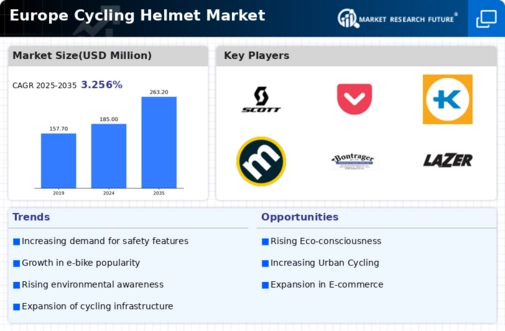Rising Health Awareness
The cycling helmet market in Europe is experiencing a surge in demand driven by increasing health consciousness among consumers. As more individuals recognize the health benefits of cycling, the need for protective gear, particularly helmets, becomes paramount. This trend is reflected in the growing number of cycling enthusiasts, with participation rates rising by approximately 15% over the past few years. Consequently, the cycling helmet market is poised for growth as consumers prioritize safety alongside fitness. Furthermore, public health campaigns promoting cycling as a sustainable mode of transport are likely to bolster this trend, encouraging more people to adopt cycling as a regular activity. As a result, the demand for high-quality helmets that meet safety standards is expected to rise, further propelling the market forward.
Government Regulations and Initiatives
Government regulations play a crucial role in shaping the cycling helmet market in Europe. Various countries have implemented stringent safety standards for helmets, which has led to an increase in the adoption of certified products. For instance, the European Union has established regulations that mandate specific safety features in helmets, thereby enhancing consumer confidence. This regulatory environment is likely to drive the market, as manufacturers are compelled to innovate and comply with these standards. Additionally, government initiatives promoting cycling as a sustainable transport option are expected to further stimulate demand. With funding for cycling infrastructure and safety campaigns, the cycling helmet market is likely to see a significant uptick in sales as more individuals are encouraged to cycle safely.
Technological Advancements in Helmet Design
The cycling helmet market in Europe is witnessing a transformation due to technological advancements in helmet design. Innovations such as improved ventilation systems, lightweight materials, and enhanced impact resistance are becoming increasingly prevalent. These advancements not only improve comfort but also increase safety, making helmets more appealing to consumers. The integration of smart technology, such as built-in lights and communication systems, is also gaining traction, potentially attracting a younger demographic. As a result, the cycling helmet market is likely to benefit from a broader consumer base, with sales projected to grow by approximately 20% in the coming years. This trend indicates a shift towards more sophisticated products that cater to the evolving needs of cyclists.
Environmental Concerns and Sustainable Practices
The cycling helmet market in Europe is increasingly influenced by environmental concerns and the demand for sustainable practices. Consumers are becoming more aware of the ecological impact of their purchases, leading to a preference for helmets made from eco-friendly materials. Manufacturers are responding by developing products that utilize recycled materials and sustainable production methods. This shift is not only beneficial for the environment but also aligns with the values of a growing segment of environmentally conscious consumers. As a result, the cycling helmet market is likely to see a rise in demand for sustainable options, with sales of eco-friendly helmets projected to increase by 25% over the next few years. This trend underscores the importance of sustainability in shaping consumer preferences.
Urbanization and Cycling Infrastructure Development
Urbanization is a significant driver of the cycling helmet market in Europe, as cities increasingly invest in cycling infrastructure. The development of dedicated bike lanes and cycling-friendly policies encourages more individuals to take up cycling as a mode of transport. This trend is reflected in the rising number of cyclists in urban areas, which has increased by approximately 30% in recent years. As more people cycle for commuting and leisure, the demand for helmets is expected to rise correspondingly. The cycling helmet market is likely to benefit from this urban shift, as municipalities promote cycling as a sustainable alternative to motor vehicles. Consequently, the market is poised for growth as safety becomes a priority for urban cyclists.






















Leave a Comment